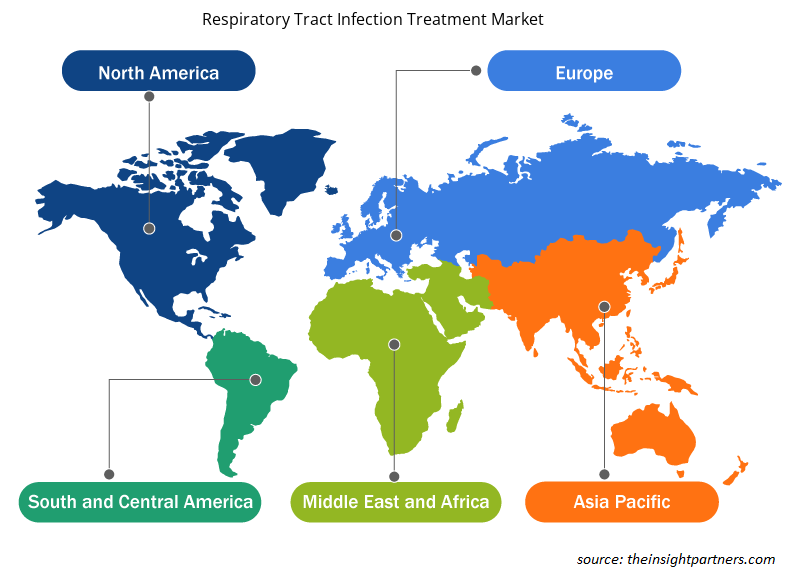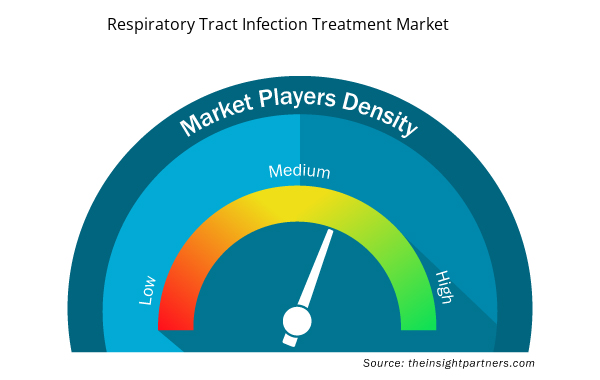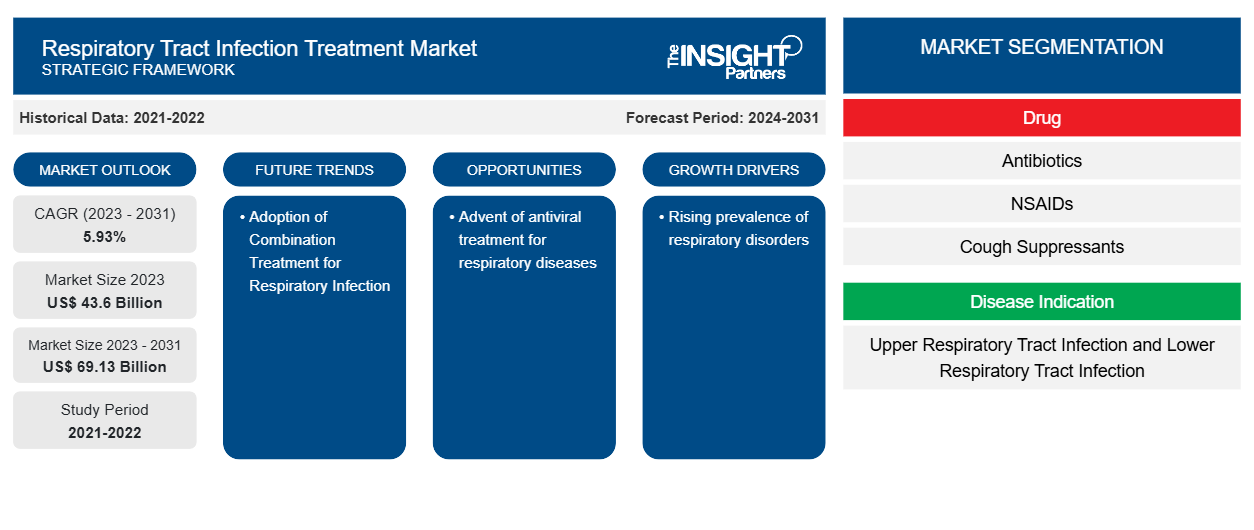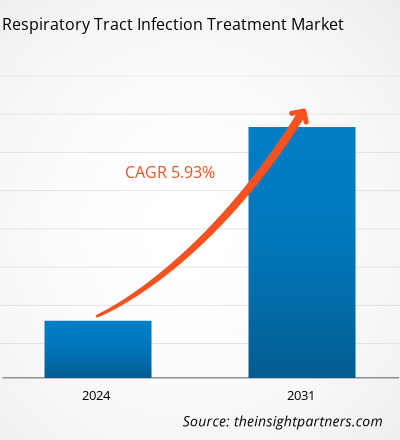من المتوقع أن يصل حجم سوق علاج عدوى الجهاز التنفسي إلى 69.13 مليار دولار أمريكي بحلول عام 2031 من 43.6 مليار دولار أمريكي في عام 2023؛ ومن المتوقع أن يسجل معدل نمو سنوي مركب بنسبة 5.93٪ خلال الفترة 2023-2031.CAGR of 5.93% during 2023–2031.
التهابات الجهاز التنفسي، أو RTIs، هي التهابات تصيب الجيوب الأنفية أو الحلق أو مجاري الهواء أو الرئتين. ويؤكد تقرير سوق علاج التهابات الجهاز التنفسي العالمي على العوامل الرئيسية التي تدفع السوق ويصور تطورات اللاعبين البارزين. وتشمل العوامل الرئيسية التي تدفع نمو السوق الانتشار المتزايد لالتهابات الجهاز التنفسي على مستوى العالم، وزيادة الوعي المتعلق بالتهابات الجهاز التنفسي والعلاجات المختلفة المتعلقة بعدوى الجهاز التنفسي، وزيادة عدد التجارب السريرية المتعلقة بعلاج عدوى الجهاز التنفسي. ومع ذلك، فإن الافتقار إلى الأبحاث التي تركز على العلاجات التنفسية والآثار السلبية المتعلقة بأدوية عدوى الجهاز التنفسي يعيق نمو السوق. وعلاوة على ذلك، من المتوقع أن يؤدي ظهور العلاج المضاد للفيروسات إلى إحداث اتجاهات جديدة في سوق علاج التهابات الجهاز التنفسي العالمية في السنوات القادمة.RTIs, are infections of the sinuses, throat, airways, or lungs. The global
محركات النمو ومعوقاته:
ارتفاع الطلب على تشخيص أمراض الجهاز التنفسي بين كبار السن
مع نمو عدد كبار السن على مستوى العالم، من المتوقع أن يزداد الطلب على تشخيص أمراض الجهاز التنفسي في السنوات القادمة. على سبيل المثال، وفقًا لمقال نُشر في المجلة البريطانية لعلم الأدوية في نوفمبر 2021، يتم تشخيص حوالي 1٪ من سكان المملكة المتحدة بالالتهاب الرئوي المكتسب من المجتمع (CAP) سنويًا. تحدث حوالي 70٪ من الحالات لدى الأشخاص الذين تزيد أعمارهم عن 65 عامًا، ويبلغ معدل الوفيات خلال 30 يومًا حوالي 20٪ في هذه الفئة العمرية. وبالتالي، من المتوقع أن يؤدي ارتفاع عدد السكان المسنين وزيادة حالات الإصابة بأمراض مثل الالتهاب الرئوي المكتسب من المجتمع إلى دفع الطلب على علاجات أمراض الجهاز التنفسي، مما يعزز النمو الإجمالي للسوق.
أدى البحث والتطوير المستمر في هذا المجال إلى ظهور اختبارات وإجراءات تشخيصية مختلفة من شأنها أن تؤثر بشكل إيجابي على نمو السوق في السنوات القادمة. ومن المتوقع أن توفر طرق التشخيص المبتكرة فرصًا جيدة لتطوير السوق خلال فترة التنبؤ. ومع ذلك، من المتوقع أن يؤدي ندرة الدراسات البحثية والآثار السلبية المتعلقة بأدوية عدوى الجهاز التنفسي إلى الحد من نمو سوق علاج عدوى الجهاز التنفسي العالمية.
قم بتخصيص هذا التقرير ليناسب متطلباتك
ستحصل على تخصيص لأي تقرير - مجانًا - بما في ذلك أجزاء من هذا التقرير، أو تحليل على مستوى الدولة، وحزمة بيانات Excel، بالإضافة إلى الاستفادة من العروض والخصومات الرائعة للشركات الناشئة والجامعات
- احصل على أهم اتجاهات السوق الرئيسية لهذا التقرير.ستتضمن هذه العينة المجانية تحليلاً للبيانات، بدءًا من اتجاهات السوق وحتى التقديرات والتوقعات.
تقسيم التقرير ونطاقه:
تم إجراء تحليل سوق علاج عدوى الجهاز التنفسي العالمي من خلال النظر في القطاعات التالية: مؤشر مرض الدواء، وطريق الإعطاء، والفئة العمرية، وقناة التوزيع. بناءً على الأدوية، يتم تقسيم السوق إلى المضادات الحيوية ، ومضادات الالتهاب غير الستيرويدية، ومثبطات السعال، ومزيلات الاحتقان الأنفي، وغيرها. من خلال مؤشر المرض، يتم تقسيم سوق علاج عدوى الجهاز التنفسي العالمي إلى عدوى الجهاز التنفسي العلوي وعدوى الجهاز التنفسي السفلي. من حيث طريق الإعطاء، يتم تقسيم السوق إلى عن طريق الفم والحقن. على أساس الفئة العمرية، يتم تصنيف السوق إلى طب الأطفال والبالغين. بناءً على قناة التوزيع، يتم تقسيم سوق علاج عدوى الجهاز التنفسي العالمي إلى صيدليات المستشفيات والصيدليات عبر الإنترنت وصيدليات التجزئة.
التحليل القطاعي:
من حيث الدواء، احتل قطاع المضادات الحيوية أكبر حصة سوقية عالمية لعلاج التهابات الجهاز التنفسي في عام 2023. ومن المتوقع أن يسجل القطاع أعلى معدل نمو سنوي مركب خلال الفترة 2023-2031. تشمل التهابات الجهاز التنفسي مجموعة من الأمراض، بما في ذلك التهاب الشعب الهوائية والالتهاب الرئوي والتهاب الجيوب الأنفية، والتي غالبًا ما تسببها مسببات الأمراض البكتيرية. تستهدف المضادات الحيوية هذه البكتيريا الضارة وتقضي عليها، مما يقلل الالتهاب ويعزز التعافي بشكل أسرع. تشمل المضادات الحيوية الموصوفة عادةً لالتهابات الجهاز التنفسي البنسلين والسيفالوسبورينات والماكروليدات والفلوروكينولونات والتتراسيكلينات، ولكل منها آليات عمل فريدة وأهداف بكتيرية.
بناءً على مؤشر المرض، احتفظ قطاع عدوى الجهاز التنفسي السفلي بحصة سوقية أكبر في عام 2023. ومن المتوقع أيضًا أن يسجل معدل نمو سنوي مركب أعلى من عام 2023 إلى عام 2031. عدوى الجهاز التنفسي السفلي هي عدوى تصيب الرئتين والشعب الهوائية، وعادة ما تسببها مسببات الأمراض البكتيرية أو الفيروسية أو الفطرية، من بين أمور أخرى. يتم تصنيف الحالات مثل الالتهاب الرئوي والتهاب الشعب الهوائية والتهاب القصيبات الهوائية، والتي تظهر عادةً أعراضًا مثل السعال المنتج وعدم الراحة في الصدر وضيق التنفس والحمى، ضمن طيف عدوى الجهاز التنفسي السفلي. الالتهاب الرئوي، وهو عدوى الجهاز التنفسي السفلي الشديدة، ينطوي على التهاب وإصابة أنسجة الرئة، مما يؤدي إلى توحيد الرئة (بعض مناطق الرئة أو العضو بالكامل) وضعف تبادل الغازات.
من حيث طريقة الإدارة، استحوذ القطاع الفموي على حصة أكبر من سوق علاج عدوى الجهاز التنفسي العالمية؛ ومن المتوقع أن يسجل القطاع معدل نمو سنوي مركب أعلى خلال الفترة 2023-2031. غالبًا ما يتم وصف المضادات الحيوية الفموية مثل أموكسيسيلين أو أزيثروميسين أو دوكسيسيكلين لمكافحة مسببات الأمراض البكتيرية المسببة لالتهابات الجهاز التنفسي. بالإضافة إلى المضادات الحيوية، قد تقلل الكورتيكوستيرويدات الفموية من الالتهاب في حالات الربو الشديد أو تفاقم مرض الانسداد الرئوي المزمن. تُستخدم الأدوية المضادة للفيروسات الفموية مثل أوسيلتاميفير لعلاج التهابات الجهاز التنفسي الفيروسية مثل الأنفلونزا. تشمل المزايا الشائعة للطريق الفموي الإدارة السهلة وامتثال المريض وتوزيع الدواء الجهازي.
من حيث الفئة العمرية، استحوذ قطاع البالغين على حصة أكبر من سوق علاج التهابات الجهاز التنفسي العالمية في عام 2023. ومن المتوقع أن يسجل قطاع طب الأطفال معدل نمو سنوي مركب أعلى خلال الفترة 2023-2031. تؤدي عوامل مثل الوعي المتعلق بأهمية التشخيص المبكر وعلاج التهابات الجهاز التنفسي لدى الأطفال والتقدم في أجهزة التنفس المستخدمة في العلاج إلى تطوير خيارات علاجية جديدة وأكثر فعالية. علاوة على ذلك، يساهم التركيز المتزايد على الرعاية الصحية الوقائية في نمو سوق قطاع طب الأطفال.
من حيث قنوات التوزيع، من المتوقع أن يشكل قطاع صيدليات المستشفيات حصة سوقية كبيرة خلال الفترة 2023-2031. تعمل صيدليات المستشفيات كمكونات رئيسية لنظام الرعاية الصحية؛ فهي تلعب دورًا حيويًا بشكل خاص في إدارة التهابات الجهاز التنفسي الحادة والشديدة، والتي تتطلب إعطاء الأدوية عن طريق الوريد أو العضل. تتحمل هذه الصيدليات مسؤولية توريد وتخزين وتوزيع المضادات الحيوية ومضادات الفيروسات والكورتيكوستيرويدات وعلاجات التهابات الجهاز التنفسي الأخرى، فضلاً عن ضمان توصيلها بأمان وفي الوقت المناسب إلى المستشفيات الداخلية والخارجية.
رؤى إقليمية حول سوق علاج عدوى الجهاز التنفسي
لقد قام المحللون في Insight Partners بشرح الاتجاهات والعوامل الإقليمية المؤثرة على سوق علاج عدوى الجهاز التنفسي طوال فترة التوقعات بشكل شامل. يناقش هذا القسم أيضًا قطاعات سوق علاج عدوى الجهاز التنفسي والجغرافيا في جميع أنحاء أمريكا الشمالية وأوروبا ومنطقة آسيا والمحيط الهادئ والشرق الأوسط وأفريقيا وأمريكا الجنوبية والوسطى.

- احصل على البيانات الإقليمية المحددة لسوق علاج عدوى الجهاز التنفسي
نطاق تقرير سوق علاج عدوى الجهاز التنفسي
| سمة التقرير | تفاصيل |
|---|---|
| حجم السوق في عام 2023 | 43.6 مليار دولار أمريكي |
| حجم السوق بحلول عام 2031 | 69.13 مليار دولار أمريكي |
| معدل النمو السنوي المركب العالمي (2023 - 2031) | 5.93% |
| البيانات التاريخية | 2021-2022 |
| فترة التنبؤ | 2024-2031 |
| القطاعات المغطاة | بواسطة المخدرات
|
| المناطق والدول المغطاة | أمريكا الشمالية
|
| قادة السوق وملفات تعريف الشركات الرئيسية |
|
كثافة اللاعبين في سوق علاج عدوى الجهاز التنفسي: فهم تأثيرها على ديناميكيات الأعمال
يشهد سوق علاج عدوى الجهاز التنفسي نموًا سريعًا، مدفوعًا بالطلب المتزايد من المستخدم النهائي بسبب عوامل مثل تفضيلات المستهلكين المتطورة والتقدم التكنولوجي والوعي المتزايد بفوائد المنتج. ومع ارتفاع الطلب، تعمل الشركات على توسيع عروضها والابتكار لتلبية احتياجات المستهلكين والاستفادة من الاتجاهات الناشئة، مما يؤدي إلى زيادة نمو السوق.
تشير كثافة اللاعبين في السوق إلى توزيع الشركات أو المؤسسات العاملة في سوق أو صناعة معينة. وهي تشير إلى عدد المنافسين (اللاعبين في السوق) الموجودين في مساحة سوق معينة نسبة إلى حجمها أو قيمتها السوقية الإجمالية.
الشركات الرئيسية العاملة في سوق علاج عدوى الجهاز التنفسي هي:
- أبوت،
- استيرازينيكا،
- سيبلا،
- ميرك وشركاه،
- شركة جلاكسو سميث كلاين
- شركة نوفارتيس ايه جي
إخلاء المسؤولية : الشركات المذكورة أعلاه ليست مرتبة بأي ترتيب معين.

- احصل على نظرة عامة على أهم اللاعبين الرئيسيين في سوق علاج عدوى الجهاز التنفسي
التحليل الإقليمي:
من المرجح أن يساهم الوعي المتزايد بين السكان حول أهمية التشخيص المبكر وعلاج التهابات الجهاز التنفسي في نمو سوق علاج عدوى الجهاز التنفسي العالمية في السنوات القادمة. يتم تقسيم السوق إلى أمريكا الشمالية وأوروبا وآسيا والمحيط الهادئ والشرق الأوسط وأفريقيا وأمريكا الجنوبية والوسطى. احتلت أمريكا الشمالية أكبر حصة سوقية عالمية لعلاج عدوى الجهاز التنفسي في عام 2023. يشهد السوق في أمريكا الشمالية نموًا كبيرًا بسبب ارتفاع معدل انتشار التهابات الجهاز التنفسي في البلاد. تساهم عوامل مثل تلوث الهواء والتدخين وظروف المعيشة المزدحمة في ارتفاع معدل الإصابة بالتهابات الجهاز التنفسي في البلاد. إن زيادة انتشار التهابات الجهاز التنفسي وزيادة الوعي بالرعاية الصحية والمبادرات الإيجابية من قبل الحكومة تدفع نمو سوق علاج عدوى الجهاز التنفسي العالمية.
المنافسة والشركات الرئيسية:
يمكن أن تساعد توقعات سوق علاج عدوى الجهاز التنفسي العالمية أصحاب المصلحة في التخطيط لاستراتيجيات النمو الخاصة بهم. تعد Abbott Laboratories و AstraZeneca plc و Alembic Pharmaceuticals Ltd. و Boehringer Ingelheim International GmbH و GlaxoSmithKline plc و Teva Pharmaceutical Industries Ltd و Novartis AG و F. Hoffmann-La Roche AG و Sanofi SA و Merck & Co. و Cipla من بين اللاعبين البارزين الذين تم عرضهم في تقرير سوق علاج عدوى الجهاز التنفسي العالمية. تركز هذه الشركات على استراتيجيات مختلفة (بما في ذلك العضوية وغير العضوية) لتلبية الطلب المتزايد من المستهلكين وتوسيع نطاق منتجاتها في محافظ متخصصة. تشمل الاستراتيجيات الرئيسية التي تتبناها الشركات في السوق إطلاق تقنيات جديدة وتطوير منتجات قائمة والتوسع الجغرافي.
- التحليل التاريخي (سنتان)، السنة الأساسية، التوقعات (7 سنوات) مع معدل النمو السنوي المركب
- تحليل PEST و SWOT
- حجم السوق والقيمة / الحجم - عالميًا وإقليميًا وقطريًا
- الصناعة والمنافسة
- مجموعة بيانات Excel


- Smart Mining Market
- Sterilization Services Market
- Smart Water Metering Market
- Cosmetic Bioactive Ingredients Market
- Enteral Nutrition Market
- Mesotherapy Market
- Medical Collagen Market
- Integrated Platform Management System Market
- Transdermal Drug Delivery System Market
- Electronic Toll Collection System Market

Report Coverage
Revenue forecast, Company Analysis, Industry landscape, Growth factors, and Trends

Segment Covered
This text is related
to segments covered.

Regional Scope
North America, Europe, Asia Pacific, Middle East & Africa, South & Central America

Country Scope
This text is related
to country scope.
الأسئلة الشائعة
Respiratory diseases such as asthma, bronchitis, allergic rhinitis, pneumonia and sinusitis can seriously impair a person's physical functioning. Symptoms associated with both mild and severe diseases of these respiratory tracts include cough, wheezing, chest pain, difficulty breathing, and shortness of breath, congestion and, in severe cases, even death. These conditions cause significant morbidity and high costs to society. Treatment of the above respiratory disease is known as respiratory tract infection treatment.
The key factors driving the respiratory tract infection treatment market growth are the demand for the diagnosis of respiratory diseases owing to the rising prevalence of these diseases coupled with rising demand for OTC products. In addition, continuous research and development in this field has resulted in various diagnostic tests and procedures that will positively affect the growth of the market in the coming years.
The respiratory tract infection treatment market was valued at US$ 43.60 billion in 2023.
The respiratory tract infection treatment market is expected to be valued at US$ 69.13 billion in 2031.
The respiratory tract infection treatment market has major market players, including Abbott Laboratories, AstraZeneca plc, Alembic Pharmaceuticals Ltd., Boehringer Ingelheim International GmbH, GlaxoSmithKline plc, Teva Pharmaceutical Industries Ltd, Novartis AG, F. Hoffmann-La Roche AG, Sanofi S.A., Merck & Co and Cipla.
Based on drug, the market is segmented into Antibiotics, NSAIDs, Cough Suppressants, Nasal Decongestants, and Others. The antibiotics segment held the largest respiratory tract infection treatment market share in 2023 and is anticipated to register the highest CAGR during 2023–2031.
Based on disease indication, the respiratory tract infection treatment market is segmented into LRTI and URTI. The LRTI is anticipated to hold a significant share by 2031.
The List of Companies - Respiratory Tract Infection Market
- Merck & Co
- Abbott
- AbbVie
- Sanofi
- GlaxoSmithKline plc
- F. Hoffmann La Roche Ltd.
- Pfizer, Inc.
- Novartis AG
- Teva Pharmaceuticals
- Boehringer Ingelheim GmbH
The Insight Partners performs research in 4 major stages: Data Collection & Secondary Research, Primary Research, Data Analysis and Data Triangulation & Final Review.
- Data Collection and Secondary Research:
As a market research and consulting firm operating from a decade, we have published and advised several client across the globe. First step for any study will start with an assessment of currently available data and insights from existing reports. Further, historical and current market information is collected from Investor Presentations, Annual Reports, SEC Filings, etc., and other information related to company’s performance and market positioning are gathered from Paid Databases (Factiva, Hoovers, and Reuters) and various other publications available in public domain.
Several associations trade associates, technical forums, institutes, societies and organization are accessed to gain technical as well as market related insights through their publications such as research papers, blogs and press releases related to the studies are referred to get cues about the market. Further, white papers, journals, magazines, and other news articles published in last 3 years are scrutinized and analyzed to understand the current market trends.
- Primary Research:
The primarily interview analysis comprise of data obtained from industry participants interview and answers to survey questions gathered by in-house primary team.
For primary research, interviews are conducted with industry experts/CEOs/Marketing Managers/VPs/Subject Matter Experts from both demand and supply side to get a 360-degree view of the market. The primary team conducts several interviews based on the complexity of the markets to understand the various market trends and dynamics which makes research more credible and precise.
A typical research interview fulfils the following functions:
- Provides first-hand information on the market size, market trends, growth trends, competitive landscape, and outlook
- Validates and strengthens in-house secondary research findings
- Develops the analysis team’s expertise and market understanding
Primary research involves email interactions and telephone interviews for each market, category, segment, and sub-segment across geographies. The participants who typically take part in such a process include, but are not limited to:
- Industry participants: VPs, business development managers, market intelligence managers and national sales managers
- Outside experts: Valuation experts, research analysts and key opinion leaders specializing in the electronics and semiconductor industry.
Below is the breakup of our primary respondents by company, designation, and region:

Once we receive the confirmation from primary research sources or primary respondents, we finalize the base year market estimation and forecast the data as per the macroeconomic and microeconomic factors assessed during data collection.
- Data Analysis:
Once data is validated through both secondary as well as primary respondents, we finalize the market estimations by hypothesis formulation and factor analysis at regional and country level.
- Macro-Economic Factor Analysis:
We analyse macroeconomic indicators such the gross domestic product (GDP), increase in the demand for goods and services across industries, technological advancement, regional economic growth, governmental policies, the influence of COVID-19, PEST analysis, and other aspects. This analysis aids in setting benchmarks for various nations/regions and approximating market splits. Additionally, the general trend of the aforementioned components aid in determining the market's development possibilities.
- Country Level Data:
Various factors that are especially aligned to the country are taken into account to determine the market size for a certain area and country, including the presence of vendors, such as headquarters and offices, the country's GDP, demand patterns, and industry growth. To comprehend the market dynamics for the nation, a number of growth variables, inhibitors, application areas, and current market trends are researched. The aforementioned elements aid in determining the country's overall market's growth potential.
- Company Profile:
The “Table of Contents” is formulated by listing and analyzing more than 25 - 30 companies operating in the market ecosystem across geographies. However, we profile only 10 companies as a standard practice in our syndicate reports. These 10 companies comprise leading, emerging, and regional players. Nonetheless, our analysis is not restricted to the 10 listed companies, we also analyze other companies present in the market to develop a holistic view and understand the prevailing trends. The “Company Profiles” section in the report covers key facts, business description, products & services, financial information, SWOT analysis, and key developments. The financial information presented is extracted from the annual reports and official documents of the publicly listed companies. Upon collecting the information for the sections of respective companies, we verify them via various primary sources and then compile the data in respective company profiles. The company level information helps us in deriving the base number as well as in forecasting the market size.
- Developing Base Number:
Aggregation of sales statistics (2020-2022) and macro-economic factor, and other secondary and primary research insights are utilized to arrive at base number and related market shares for 2022. The data gaps are identified in this step and relevant market data is analyzed, collected from paid primary interviews or databases. On finalizing the base year market size, forecasts are developed on the basis of macro-economic, industry and market growth factors and company level analysis.
- Data Triangulation and Final Review:
The market findings and base year market size calculations are validated from supply as well as demand side. Demand side validations are based on macro-economic factor analysis and benchmarks for respective regions and countries. In case of supply side validations, revenues of major companies are estimated (in case not available) based on industry benchmark, approximate number of employees, product portfolio, and primary interviews revenues are gathered. Further revenue from target product/service segment is assessed to avoid overshooting of market statistics. In case of heavy deviations between supply and demand side values, all thes steps are repeated to achieve synchronization.
We follow an iterative model, wherein we share our research findings with Subject Matter Experts (SME’s) and Key Opinion Leaders (KOLs) until consensus view of the market is not formulated – this model negates any drastic deviation in the opinions of experts. Only validated and universally acceptable research findings are quoted in our reports.
We have important check points that we use to validate our research findings – which we call – data triangulation, where we validate the information, we generate from secondary sources with primary interviews and then we re-validate with our internal data bases and Subject matter experts. This comprehensive model enables us to deliver high quality, reliable data in shortest possible time.


 احصل على عينة مجانية لهذا التقرير
احصل على عينة مجانية لهذا التقرير